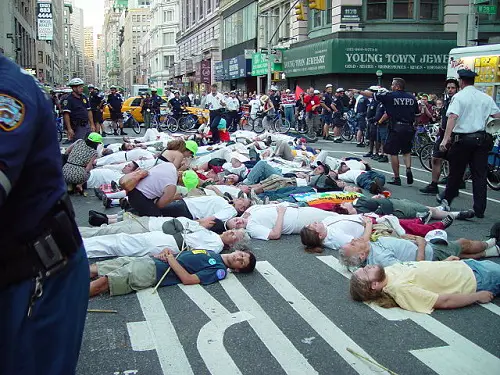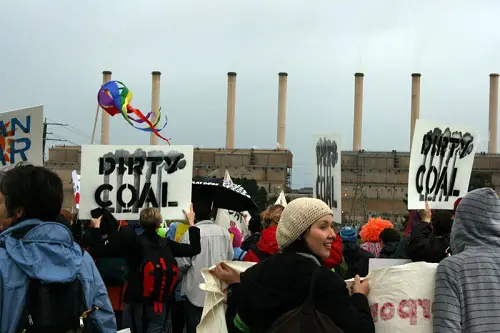
Introduction
It is sometimes argued that protesting against government policies by means of civil disobedience or non-cooperation are tantamount to the same thing. Although both do form part of the greater ambit of protest against the government or its policies, a distinction does indeed exist between the two forms of protest. Thus, they can be considered different forms of protest. Historically non-cooperation at a government level can morph into civil disobedience if the original aims of the protest are not met.
In the article which follows an investigation of both non-cooperation and civil disobedience will occur. Then constantly refer to a historical case study which is intended to highlight the difference between the two differing forms of protest. The historical case study will be an investigation into the forms of protest adopted by Gandhi in the struggle for Indian independence from British colonial rule. This instance in Indian history has served to influence and motivate other movements across the globe including the Civil Rights movement in the US and the fight against Apartheid in South Africa.
It is often argued that both civil disobedience and non-cooperation must be inherently nonviolent. I concur with this assumption. It is important for movements fighting for civil justice, environmental justice or even a perceived threat that the movements must remain nonviolent in order to convey the moral superiority of their cause (Brownlee 2016). As soon as protests become violent it is far easier to public sentiment to sway against the movement and for governments to stop movements as the movement is now a threat to public safety. This may be a real or perceived threat, regardless the government can far more easily prosecute members who turn violent.
Non-cooperation
Non-cooperation as a form of protest can be defined as a “failure or refusal to cooperate…” (Collins Dictionary) with government decrees. Forms of this protest can be seen in India when sections of the public under the leadership of Gandhi took their children out of state schools, government official and military personal resigned as well as a general boycott of the courts (Kamat 2005). A non-cooperation protest would fall short of actually breaking the law but it is intended to inconvenience government operations. The aim, if enough people join would be to halt government policy as it cannot practically complete any of the tasks the government sets out to do.
In India the Non-cooperation Movement started by Gandhi in the 1920’s, also referred to as Asahakar, involved activities mentioned above directed at British colonial rule. Included in the already mentioned activities was also the surrendering of title deeds to property as a symbolic act meant to highlight that Indians could not own land if they were not allowed to self-govern themselves. This movement was widely regarded as a failure as it did not achieve the overall goal of Indian self-governance. However, it can be argued that the movement helped give a voice to those previously seen as voiceless. Many peasants and women, not generally seen to have a voice in how the country should be run were able to join the movement and have their voice heard (Kamat 2005).
Gandhi realized that the movement would not achieve its desired aim. This caused him to re-evaluate what could be done to ensure a future India ruled by Indians. Thus in the 1930s, the Indian campaign of civil disobedience began.
Civil Disobedience
Civil disobedience can be seen as an extension of non-cooperation and vice versa. However, if you are looking for a distinction, civil disobedience has come to represent the actual and wilful breaking of laws in order to highlight an injustice. It is this facet of law breaking that differentiates civil disobedience from non-cooperation. It was originally Henry David Thoreau who coined the term civil disobedience in his landmark essay of the same title (Brownlee 2016). He developed the theoretical framework around his response to the Mexican war and the Fugitive Slave Law which he felt was unjust and immoral. His actual response to the war and the above mentioned law was to stop paying his taxes to the American government at the time which is a crime. Thoreau saw at his moral imperative to break the law, something he did with full knowledge of the consequences. Thoreau phrased his dilemma as such:
“Unjust laws exist: shall we be content to obey them, or shall we endeavor to amend them, and obey them until we have succeeded, or shall we transgress them at once? Men generally, under such a government as this, think that they ought to wait until they have persuaded the majority to alter them. They think that, if they should resist, the remedy would be worse than the evil. But it is the fault of the government itself that the remedy is worse than the evil. It makes it worse. Why is it not more apt to anticipate and provide for reform? Why does it not cherish its wise minority? Why does it cry and resist before it is hurt? Why does it not encourage its citizens to be on the alert to point out its faults, and do better than it would have them? Why does it always crucify Christ, and excommunicate Copernicus and Luther, and pronounce Washington and Franklin rebels?” (Thoreau 1849)
Recent events in the United States, from the inauguration of President Trump to the violent protests ACLU campus, has brought the debate of civil disobedience again to the fore (Cobb 2017). Often such debates center around the morality of breaking the law even if for a noble cause. The answer to this normally depends on ones on worldview but many philosophers have weighed in on the topic with some agreeing that if the law is broken by a person intentionally and without resort, to violence, the action can be deemed to be moral (Brownlee 2016). The violent protests at the ACLU campus should perhaps not be seen as a civil disobedience movement as they sought to highlight injustice but rather attempted to have their opinions heard. This sadly turned violent and can be argued that their actions did more damage rather than addressing an injustice.
On returning to our historical case study, Gandhi and many of his follow broke the so-called Salt Law in the 1930s (Kamat 2005). This law sought to impose a tax on salt produced in India and sold to Indians. This drastically increased the price of salt making it unaffordable for most, it also caused an increase in diseases resulting from iodine deficiencies as iodine is found in salt. Gandhi and his followers protested the law by organizing a march, at the march Gandhi and his followers proceeded to mine salt illegally thus breaking the Salt Law. Gandhi and many of his followers were subsequently arrested and tried In this case the law breaking sought to do no discernible harm to individuals. Rather the breaking of the law was seen to raise public awareness as to the injustice of the law and inconvenience government rather than incite violent revolution. This facet of breaking the law not to cause harm and in non-violent ways is a trademark of civil disobedience movements the world over.
Conclusion
As has been alluded to above although both civil disobedience and non-cooperation form part of the greater definition of protest, both have traits that discern them from one another. In summary, non-cooperation falls short of breaking any law while civil disobedience requires the wilful breaking of a countries laws to highlight injustice. Throughout the 20th century, we can see examples of very effective civil disobedience movements from the Civil Rights movement to the fight against Apartheid and greater colonial rule in Africa. What makes this movement successful is they steer clear of the polarizing force violence has on society. There is definitely scope for further civil disobedience movements in our modern times with many institutional injustices to stand against but by pursuing non-violent action hopefully lasting change can be achieved.










